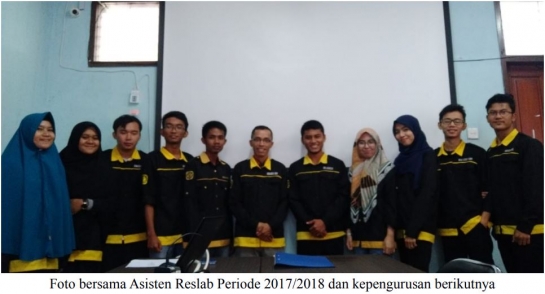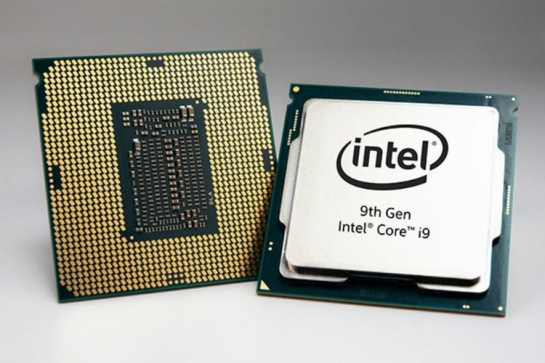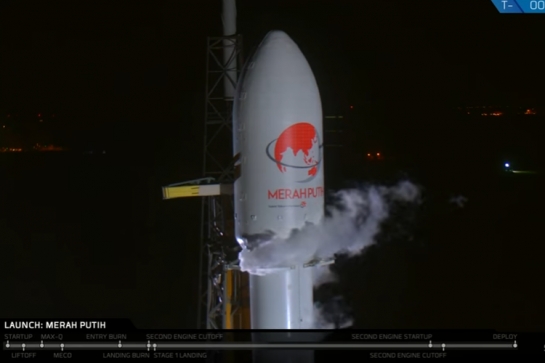 RESLAB | Teknik Komputer Universitas Andalas
RESLAB | Teknik Komputer Universitas Andalas
RESLAB | Teknik Komputer Universitas Andalas
RESLAB | Teknik Komputer Universitas Andalas
Padang – Senin, (24/09/2018) Reslab SK-UA resmi memiliki pengurus yang baru. Bertempat di Laboratorium Robotica and Embedded System, Jurusan Sistem Komputer, Universitas Andalas telah dilaksanakan pelantikan dan serah terima jabatan kepengurusan Reslab 2017/2018 dari saudara Junaidi kepada kepengurusan baru yakni saudara Ronaldo untuk periode 2018/2019.
Sebelumnya, pemilihan Koordinator Reslab telah dilakukan secara musyawarah pada Senin pagi oleh seluruh asisten Reslab dan Kepala Laboratorium. Hasil yang diperoleh adalah memilih Ronaldo, Mahasiswa Sistem Komputer angkatan 2015 sebagai koordinator Reslab yang baru.
Kepala Laboratorium Reslab, Budi Rahmadya, M.Eng memimpin langsung pengambilan sumpah pelantikan yang disaksikan oleh para asisten Laboratorium. Dilanjutkan dengan serah terima jabatan secara simbolis berupa penyerahan kunci laboratorium dari Saudara Junaidi Putra P., selaku Koordinator Reslab periode 2017/2018 kepada Saudara Ronaldo selaku Koordinator Reslab terpilih untuk periode 2018/2019. Diakhiri dengan ucapan terimakasih oleh Koordinator Reslab yang baru “Terimakasih kepada teman-teman dan bapak yang sudah percaya dengan memberikan amanah ini kepada saya, saya punya banyak mimpi untuk Reslab kedepannya tapi saya bukanlah apa-apa tanpa teman-teman asisten semua, mohon kerjasamanya”, pungkas Aldo.
Penulis : Ayuning Khairun Nisya
Intel akhirnya meluncurkan secara resmi lini prosesor generasi kesembilan, pada Selasa (9/10/2018). Prosesor-prosesor generasi kesembilan itu termasuk prosesor Core i5, Core i7, dan prosesor flagship yang akan muncul perdana secara umum, Core i9. Selain itu, Intel juga meresmika, Intel Core seri X. Hal unik yang perlu disorot adalah prosesor gaming Core i9, yang diklaim sebagai prosesor gaming terbaik di dunia. Sebagaimana dikutip dari keterangan tertulis yang diterima KompasTekno, Selasa, (9/10/2018), Core i9 diklaim memiliki kemampuan menaikkan FPS game sebesar 10 persen dari generasi sebelumnya, dan 37 persen dari prosesor Intel yang telah berumur 3 tahun. Ada pula fitur Intel Turbo Boost Technology 2.0, fitur untuk menaikkan kemampuan single-core kepada kemampuan maksimalnya (5,0 GHz).
Para konten kreator pun diklaim akan lebih 'dimanjakan' dengan teknologi terbaru Core i9, karena dari segi multimedia, prosesor menaikkan kemampuannya sebesar 41 persen ketika merekam game, edit video dan render 34 persen lebih cepat, dan peningkatan proses secara umum sebesar 15 persen dari generasi sebelumnya. Secara spesifikasi, dirangkum KompasTekno dari Extremetech, tipe Core i9-9900K memiliki 8 core dan 16 threads berkecepatan 3,6 GHz untuk pemakaian normal, sampai maksimum 5 GHz untuk proses berat seperti desain dan gaming. L3 cache Core i9-9900K pun berkapasitas 16 MB, dibekali dengan chip grafis Intel UHD 620. Selain Core i9, Intel juga merilis tipe Core i7-9700K dengan 8 core dan 8 thread, memiliki L3 cache 12 MB, serta berkecepatan 3,6 GHz - 4,9 GHz (turbo). Lalu ada Core i5-9600K 6 core dengan 6 thread dan besar L3 cache yang sama, 12MB, berkecepatan 3,7 GHz - 4,5 GHz (turbo). Adapun Intel Core tipe X memiliki 7 lini produk, yaitu i7-9800X, i9-9820X, i9-9900X, i9-9920X, i9-9940X, i9-9960X, dan i9-9980XE. Prosesor Intel tipe X ini diklaim memiliki 8 hingga 18 core dengan Turbo Boost Max Technology 3.0 untuk kinerja yang lebih optimal dari seri biasa. Dari segi ukuran, prosesor-prosesor ini masih menggunakan besar 14 nm, karena kabarnya Intel menunda peluncuran prosesor 10 nm sampai tahun 2019 mendatang. Bahkan, prosesor 14 nm masih akan diproduksi sampai tahun 2019. Harga prosesor Intel teranyar ini bervariasi. Prosesor Core i9 dibanderol 488 dollar AS (setara Rp 7,4 juta), Core i7 399 dollar AS (setara Rp 5,7 juta), sementara Core i5 295 dollar AS (setara dengan Rp 4,5 juta).
Artikel ini telah tayang di Kompas.com dengan judul "Intel Resmikan Prosesor Generasi Ke-9, Termasuk Core i9 dan X-Series", https://tekno.kompas.com/read/2018/10/09/15430177/intel-resmikan-prosesor-generasi-ke-9-termasuk-core-i9-dan-x-series.
Penulis : Bill Clinten
Editor : Reska K. Nistanto
Android Pie, the latest version of Google's mobile operating system, is stuffed with features that address some of the hottest tech controversies head-on, including smartphone addiction and privacy. It also has some changes that could create a little drama, like the sometimes missing back button.
Google released Pie -- the name follows the company's penchant for naming its mobile OS after desserts -- on Monday. It offers some significant improvements over Oreo, and anyone with a Pixel phone can start enjoying them today. Everyone else will have to wait a few weeks or even months.
The ninth iteration of the world's most popular phone operating system provides a glimpse at the future of phones. Here's how.
Using a smartphone less is good for smartphone makers
The hottest smartphone trend this year is using your smartphone less. This year, Google and Apple acknowledged that consumers' infatuation with their phones is a growing problem and introduced some helpful features to address the issue.
Google announced its "Digital Wellbeing" tools at the I/O developer conference in May, and is rolling them out in the Pie beta for Pixel users now. They include a dashboard that shows you exactly how bad your problem is by listing how many minutes (ok, hours) you've spent in each app. There is also a timer that grays out apps after a set amount of time in an attempt to cut down on usage, and a "Wind Down" feature for transitioning from phone time to bed time with a grayed-out screen.
Social media and news aren't the only things keeping us glued to smartphones. Work is also a culprit, and Android Pie offers some help there, too. Android phones already let you create separate work and personal profiles on one device; Pie adds a switch to disable work mode, like turning off your office light when you finally leave at 6 pm.
Andrew Hewitt, an analyst at Forrester, says that feature could help Android expand further into the business world, where companies are reconsidering their go-go-go mentality that often expects employees to be available 24/7.
Batteries aren't getting much better, yet
Android P features some clever software fixes to help extend battery life. It determines which apps you use most and allocates more juice for them. The screen also adjusts brightness automatically.
Hardware makers rely increasingly upon software fixes to address battery shortcomings and meet consumer demands. The most notable example was Apple's botched throttling feature last year that slowed down some phones with low batteries to prevent them from suddenly shutting down. Although we've seen some improvements to batteries, they're typically matched by increased processor demands from features like augmented reality and geolocation running in the background, said IDC mobile phone analyst William Stofega.
"When you look at the race between computer power that's on these phones versus the stored-power part of it, [batteries] are way behind," said Stofega.
Software and AI fixes aren't necessarily the solution to the battery problem. They are a bridge to help equipment manufacturers make it until real innovation can produce better batteries, Hewitt said.
Everyone is worried about privacy
Between Europe's expansive new privacy regulations and Facebook's struggles with customer privacy issues, 2018 was the year consumers became painfully aware of their privacy (or lack thereof) online.
Apple has long played up its stricter approaches to consumer privacy through features like on-device processing of photos, and now Google is adding additional protections to Android Pie. Many are under the hood, like a permissions change that will require app developers to get specific permission to access your call logs. The new operating system also will restrict access to sensitive sensors like your microphone and camera while an app is running in the background.
Hewitt thinks the privacy changes, like the Digital Wellbeing features, could help expand Android's appeal to corporate and enterprise customers.
Buttons are dying
Voice and gesture controls are infiltrating smartphone design, thanks to improvements in technology like natural language processing. Android Pie has removed some buttons and replaced them with a gesture based system — a combination of swipes and scrolls to dance around the interface.
Some users will surely lament the loss of a back button. But change is hard, and advances in technology mean buttons are no longer the only way to get around phones. Voice is also taking over some basic functions, and make the devices more adaptable to different situations such as driving.
Satelit Merah Putih milik PT Telkom Indonesia (Persero) Tbk telah meluncur ke orbit bersama SpaceX Falcon 9, dari Cape Canaveral Air Force Station, Florida, sekitar pukul 12:18 WIB. Satelit Merah Putih akan menempati slot orbit 108 derajat Bujur Timur (108 BT). Satelit Merah Putih direncanakan akan melayani wilayah telekomunikasi di Indonesia dan Internasional. Ia memiliki kapasitas 60 transponder aktif yang terdiri dari 24 transponder C-Band dan 12 transponder Extended C-Band yang akan melayani telekomunikasi wilayah Indonesia dan Asia Tenggara. Sementara itu, 24 transponder c-Band lainnya akan menjangkau wilayah Asia Tenggara. Satelit ini menggunakan platform SSL1300 besutan Space System Loral yang didesain tahan selama 16 tahun.
Anda juga dapat menyaksikan peluncuran satelit Merah Putih secara langsung lewat tautan di bawah ini.
Sebagai informasi, satelit Merah Putih akan menggantikan tugas satelit Telkom-1 yang sudah mengorbit sejak 4 Agustus 1999. Dilansir NPR, Selasa (7/8/2018), ini adalah satelit pertama yang diluncurkan roket Falcon 9 dengan pendorong Block 5 setelah diperbarui. Sebelumnya Falcon 9 mengirim satelit Bangladesh, pada 11 Mei 2018. Sejak saat itu, SpaceX terus melakukan pemeriksaan dan perbaikan. Tujuannya adalah untuk menekan biaya dan menghemat waktu penyelesaian misi. CEO SpaceX, Elon Musk, mengklaim Falcon 9 dengan pendorong Block 5 adalah roket paling andal yang pernah dibuatnya. "Misalnya kami membuat sirip (roket) - yang digunakan untuk mengarahkan roket kembali ke bumi - dari titanium supaya roket tidak terbakar dalam perjalanan pulang," terang Musk kepada The Verge, Selasa (7/8/2018). "Mesin juga memiliki pelindung panas baru yang menjaga roket dalam suhu tinggi selama terjun melalui atmosfer. Selain itu, struktur yang menahan mesin ke bagian bawah roket sekarang menggunakan kunci bukan dilas, hal ini agar lebih mudah saat memisahkan diri."













